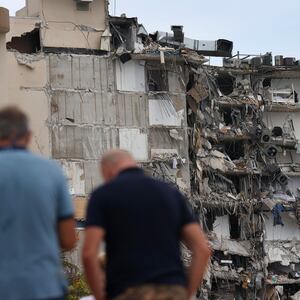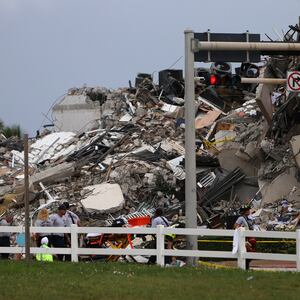MIAMI—Thick, black smoke engulfed the site of a Miami-area condo collapse on Friday afternoon, hindering the already desperate efforts to rescue survivors from the rubble.
Frequent fires and heavy rain have provided constant obstacles. Around 4 p.m., an extremely thick cloud of smoke filled the sky and at least three fire trucks were seen heading toward the collapse site. The smoke covered the rubble and made it difficult to see.
“The weather had been our main obstacle,” Howard Lieberman, a member of Miami-Dade’s urban search and rescue task force, told The Daily Beast.
ADVERTISEMENT
As many as 159 people were still missing on Friday afternoon, after an entire side of the Champlain Towers complex in Surfside abruptly collapsed in the wee hours of Thursday morning. Miami-Dade Mayor Daniella Levine Cava said the death toll stands at four—but has made it clear that the number is certain to rise. The building, erected in 1981, was undergoing a routine 40-year inspection.
Stacie Fang, whose 15-year-old son Jonah was dramatically rescued from the rubble, was the first to be identified by the Miami-Dade Medical Examiner’s Office as one of the four victims. According to social media profiles under the same name, she was vice president of a Miami marketing consultancy who relocated to Florida from New York’s Staten Island.
“There are no words to describe the tragic loss of our beloved Stacie,” her family said in a brief statement. “The many heartfelt words of encouragement and love have served as a much needed source of strength during this devastating time.”
After solemnly admitting on Friday morning that crews had a “tragic night,” Cava said that first responders were painstakingly lifting debris and were “desperate to find people.”
Chief Ray Jadallah of Miami-Dade Fire Rescue said on Friday that crews reported hearing noises under the pile overnight.
“We have hope, and every time that we hear a sound, we concentrate on that area... as we continue to hear those sounds, we concentrate on those areas,” said the fire chief. “The entire building—the portion that’s still standing—was cleared by rescue crews. So at this point, all resources have been shifted to the rubble, including from above and from below.”
Some 130 firefighters are working at the site of the disaster as heavy rain barreled through the area. Some are sifting through rubble by hand. Around 1 p.m., cranes worked to lift and move rubble and plumes of smoke littered the sky.
A block away from the clouded ground zero, Oscar Jara, 41, stood before a line of police tape, looking at the slow burning rubble.
“Incredible,” he said, adding that he meant it in the worst way. “So many people lost their lives. So fast.”
Jara works in interior construction and has repaired apartments in the area. “I know this place,” he said. “It’s just so sad for all those people under there.”
Family members of victims, who’d been on site for well over 24 hours by Friday afternoon, were tired and growing increasingly frustrated. The fact that only a handful of people had been recovered from the rubble angered some and made others question how much hope they should even dare have.
“I just want them to tell me my sister is dead,” said a woman who identified herself as the sister of Cassondra Stratton, 40, who she said has been missing since the collapse. “I just want closure.” She walked off in tears before she could share her name.
The cousin of another victim who declined to be identified was similarly frustrated.
“There is a war going on in my family right now,” she told The Daily Beast. One side, she said, was placing their complete trust in first responder efforts.
“Oh, we have to trust them. They’re doing the best work ever,” she said. But others, like her, are more critical. “There’s 150 people in there. What’s taking them so long?” she wondered.
She said she didn’t want to be harsh on the people trying to help, but was certain her cousin was alive under the rubble—and felt like time is running out.
“I know we have to put trust in them,” she said of the first responders. “But where are the results?”
Lieberman, 47, a trauma surgeon and medical manager who was on site to aid rescue crews and treat patients, said they “unfortunately” had not received any patients.
“They’re out in there in all their gear sweating like crazy,” he said of the rescue crews. “A lot of them haven’t slept in 40 hours and they just go at it.”
It remains unclear what caused the collapse, and Gov. Ron DeSantis on Friday afternoon demanded timely answers.
“We need a definitive explanation for how this could have happened,” he said during a press conference.
He said the state would support local investigative efforts to identify what caused the building’s sudden fall, adding that President Joe Biden had offered the support of federal personnel in the effort as well.
The Champlain Towers complex in Surfside has been suffering from structural issues for years. One expert told The Daily Beast that the complex had been slowly sinking into the earth for decades, and it’s known to have been the subject of at least one lawsuit in 2015, over the upkeep of the structure’s outer walls.
Daniel Wagner, the lawyer representing the resident in the suit, told The Daily Beast that his client’s own experience with visibly broken stucco, exposed concrete and corroded steel in her first-floor condo might have forecasted broader building issues.
“I think that our lawsuit and the allegations that we made in our complaint paint a picture of what may have been a much larger problem within the building,” Wagner said. The resident’s condo was destroyed in Thursday’s collapse.
Prof. Shimon Wdowinski, who authored the 2020 study that found the ground had been sinking underneath the Champlain Towers for years, could not say what caused the collapse.
“It might be that the foundation moved downward, or just part of it, and they call this ‘differential subsidence.’ And that can cause tension in the building and cause cracks,” he said.
“Maybe the foundation didn’t move, but another part of the building was subjected to some sort of structural damage or was compromised and the building moved. But we cannot say...we just were able to detect that the building was sinking.”
The building had also been undergoing some roof repair at the time of the collapse.
One man said his mom, who lived in the building, called him on Wednesday and complained about being woken up by “creaking noises” the previous night. Pablo Rodriguez told CNN, “She just told me she had woken up around 3, 4 in the morning and had heard like some creaking noises... They were loud enough to wake her... Now, in hindsight, you always wonder.” His mother and grandmother are both missing.
Armin Mehrabi, a civil engineer and FIU professor who specializes in the inspection and evaluation of cable-supported bridges, said one extremely important lesson that can already be learned from the Champlain Towers collapse is that the 40-year inspection interval for oceanfront buildings needs to be revisited.
“I think certain high-rise buildings located in certain locations need to be structurally inspected more frequently,” Mehrabi told The Daily Beast. “Maybe every five to 10 years. Every 40 years is way too long. I mean, we inspect every bridge in the U.S. once every two years. You’re going to have to do the same thing for buildings.”
Said Wdowinski, “We have an amazing technology that exists already for 30 years, that can actually detect such small movements. And it might be important to implement it in a more rigorous way to detect a potential failure in buildings and maybe prevent such things in the future.”
President Biden on Friday approved an emergency declaration in Florida and ordered federal aid be provided to bolster state and local recovery efforts. “Specifically, FEMA is authorized to identify, mobilize, and provide at its discretion, equipment and resources necessary to alleviate the impacts of the emergency,” a statement from the agency said.











